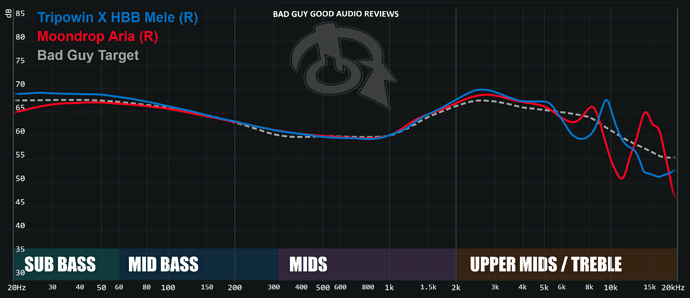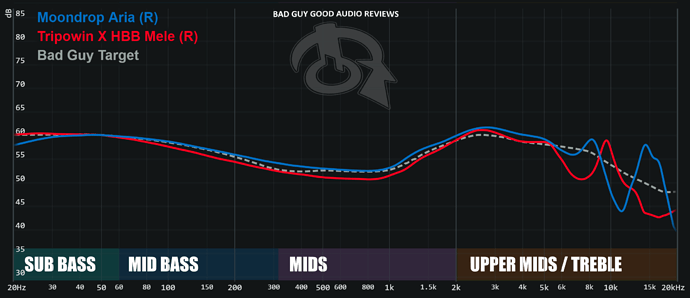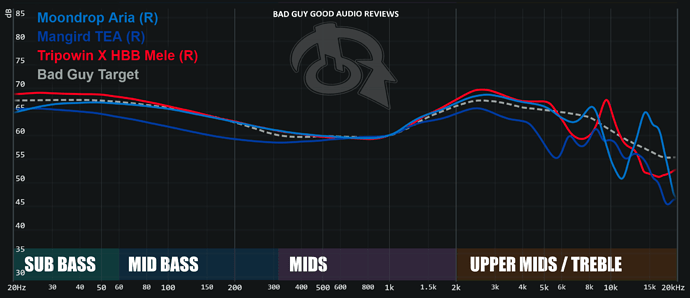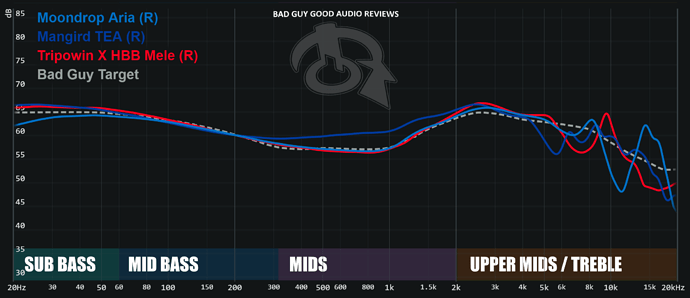Some cool guy named Morphon posted this in another forum. Tought it would be cool to share here and might help some people here:
Ok - quick non-scientific comparison.
Tracks:
Sonata 1 in F Major (Yo-Yo Ma and Emmanuel Ax)
My Way, Soon (Greta Van Fleet)
Last Words (GoGo Penguin)
Funky Gospel (Jeff Lorber Fusion)
Holy City (Joan as Policewoman)
Wonderland (Caravan Palace)All tracks were streamed from Qobuz lossless (and hi-rez when possible). DAC is a SMSL Sanskrit 10th Mk2. Amplified though a DROP+THX AAA-789. I used balanced outs when possible.
All these are comparisons vs MELE (using the Tripowin Jelly cable and Sedna Xelastec tips):
VS Moondrop Starfield (stock cable and tips)
Sonata 1 - Sounds very similar. Fairly equivalent
My Way, Soon - Kick drums less authoritative. Highs are less sibilant. Vocals about the same.
Last Words - Attack on percussion better defined. Highs are rendered with more detail.
Funky Gospel - MUCH less weight on kick drums. “edges” of high percussion much more detectable. Better instrument separation.
Holy City - Bass lines more clean, but without less power. Vocals about the same. Tambourine is much better defined.
Wonderland - Much easier to listen “into” the mix. Bass is a lot less fun. Somewhat harsh on the upper mids.Verdict - These were less similar than I would have expected from the charts. Starfield has better detail. I think I actually prefer the tuning on the MELE though. Sounds more natural.
VS CCA CA16 (Tripowin Zonie balanced cable and Spinfit CP800 tips)
Sonata 1 - Cello sounds curiously hollow, though the piano has pleasant detail. Cello bow is muted. Weird. I would definitely choose the MELE for classical/chamber.
My Way, Soon - Feels like more detail, but with some treble harshness. All the body sucked out of the vocals. Kick drum is there, but not authoritative (BA bass)
Funky Gospel - MUCH more detail on percussion strikes. Much better instrument separation. BA bass still obvious. Too V-shaped to sound natural.
Holy City - Slightly more sibilant in exchange for a much greater spatial separation and better defined instruments. Slightly metallic edge on horns not there on the MELE
Wonderland - Graphs like it should have more bass than the MELE, but definitely doesn’t sound like it. High-frequencies harsh in comparison, but it’s much easier to identify all the samples in the mix.Verdict - MELE tuning wins out again. CA16 has a lot of detail for the price, but you lose out on realism. I think the CA16 would be quite a bit more fatiguing over time.
VS Thor Mjolnir (Tripowin C16 Balanced cable, Sedna Xelastec tips)
Sonata 1 - Greater sense of perceived detail. Piano action clearly audible, unlike the MELE. Bass does not seem overly boosted.
My Way, Soon - Seems bassy in comparison. High percussion is about the same amount as the MELE, but with greater detail (egg shake, for example, is much clearer). Just feels like too much bass to be enjoyable here.
Funky Gospel - Greater treble detail here. Piano is more realistic. Decay on high-hat is much more natural. Distortion limitations of the original recording are detectable.
Holy City - BASS sounds amazing. No loss of detail on the highs. Very clearly difference between solo and backing vocals. Totally coherent and non-fatiguing.
Wonderland - Better sense of air around the vocals. And yes, better clarity on the highs. Easier to hear the samples punch in and out.Verdict - For being bass cannons, the Mjolnir has a remarkably delicate high frequency range and realistic vocals. I would say if you were fine with slightly more bass, these would be a strong upgrade from the MELE.
VS BQEYZ Spring 1 (Mesh mod) (Tripowin Zonie balanced cable, Sedna Xelastec tips)
Sonata 1 - Starting to get a sense of space around the instruments.
My Way, Soon - Bass is thuddy, not as clean as the MELE. Vocals sound slightly more recessed in comparison to the MELE.
Funky Gospel - More energetic highs. Transients are cleaner. Much wider soundstage.
Holy City - Better sense of balance across the spectrum than the MELE. Sizzles. Super low notes don’t resonate as well as the MELE.
Wonderland - Much better separation than anything before it in this list. Bass not as authoritative as the MELE. Highs slightly metallic, though not sibilant. Much more high frequency energy. Exciting, though probably more fatiguing.Verdict - As you can probably tell, I’m a detail fiend, so the Spring 1 (Mesh mod should sound about the same as the Spring 2) is my cup of tea. I wish the bass were cleaner and more authoritative. I think it’s much, much better than the MELE when it comes to micro-details, but is probably 5% behind in tuning, and 15% behind in bass quality.
VS TF10 (unknown balanced cable, Spinfit CP-100 tips)
My Way, Soon - Bass is very light (BA). Highs more splashy (not in a good way). Transient attack is very clear, better than the MELE. Vocals not always distinct.
Funky Gospel - Almost no bass weight (a slap, not a thud). Better detail. Highs too energetic. Will be fatiguing in comparison to the MELE. Soundstage is solid.
Holy City - Snare drum attack more realistic. Bass line is there, but without any impact. Sounds good. Technically better than the MELE, but nowhere near as fun.
Wonderland - Bass is almost as loud, but with almost no weight. Energetic highs overpower the music. MELE is clearly better for this kind of electronic music.Verdict - This used to be the absolute pinnacle of universal IEMs and it’s nice to see it still doing well. Probably not an important comparison.
VS Monarch (stock balanced cable, Spinfit CP-100 tips)
Sonata 1 - Piano hammers are effortlessly present. Bow is more audible.
My Way, Soon - Bass sounds more “correct” Vocals are almost holographic. Guitar overdubs are more distinct. Bass is much less present, but it has solid weight (not BA bass).
Funky Gospel - Much greater sense of instrument separation. Transients are exquisitely articulated. Recording equipment is audible. Characteristic distortion of the Rhoades piano is more evident.
Holy City - Vocal clarity is much higher. Percussion strikes are perfectly rendered. Bassline is much lower in the mix. Less fun than the MELE.
Wonderland - Bass in this track is above the sub shelf of the Monarch. So while we’re basically drowning in detail (all in perfect clarity), there is much less “fun” on this track.Verdict - These are really not trying to do the same thing as the MELE, so the comparison is a bit weird. The Monarch is for finding flaws in a recording. No romanticism. If you have a perfect recording (Like the Yo-Yo Ma album) then you’re treated to probably the most realistic and transparent set of transducers I’ve ever heard. If you want to bring the fun, these aren’t the ticket, mainly because a lot of rock has the kick drum EQd into higher frequencies so it will be audible on crappy earbuds and car stereos. But for distinguishing between all the different bass components of “Compound Fracture” by My Morning Wood, or feeling the floor rattle with a pipe organ, these are the best I’ve ever heard.
So - what about the MELE overall?
I think it’s probably the very best sounding options in the bargain/budget range. The BL03 are almost the same price once you put in decent eartips, cable, and case. And the MELE comes with perfectly fine accessories so you don’t really need anything other than what comes in the box. It has one of the most fun and pleasing tunings I’ve heard. The only true weakness is detail. While this is especially evident in high-frequency transients, it’s also noticeable in blunted snare drums, and the lack of microphone presence in tracks like “I’m Just a Kid” by Simple Plan. You can get those in the same price range (ish) with sets like the GK10 or CA16, but then you give up a lot of tonality and timbre in exchange.I mean - so what that the Thor Mjolnir is better in almost every way? It costs 4x the MELE and is almost impossible to purchase. I think in the $15-$50 range the MELE is king. If you can spend TWICE as much for the Starfield, that’s probably the better buy mainly because of the extra detail you get (and like I said - I’m a detail fiend). If you already have a Spring, or one of the Thieaudio Tribrids (or Mangird Tea, or equivalent) then you aren’t missing out on anything.
Solid set. Especially for the money. I’m impressed.






